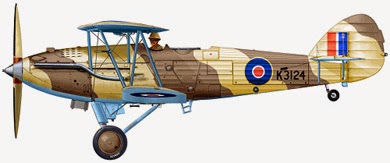Hawker Audax
Tras la primeras experiencias de
bombardeo diurno con el Hawker Hart quedó patente que los bombarderos tendrían
que poder desempeñar una cierta variedad de roles en el campo de batalla
moderno. El Ejército requería un aparato de cooperación que reemplazase los
mediocres Armstrong Whitworth Atlas y Westland Wapiti. Los requisitos para el
nuevo aparato surgieron en 1926, el bombardero ligero sería de construcción
metálica, con una tripulación de dos hombres y una velocidad máxima de 258
Km/h. Al concurso participaron tres empresas, Hawker, Avro y de Havilland
volando el primer prototipo de Hawker en junio de 1928. Finalmente sería el
proyecto de Hawker el que se alzaría con el contrato.
El Audax podía
alcanzar una velocidad máxima de 274 Km/h con una velocidad de crucero de 240
Km/h. Su techo de servicio era de 6.400 m y tenía una autonomía de 600 Km. Su
armamento consistía en 2 o 4 ametralladoras de 7´7 mm y podía transportar hasta
250 Kg en bombas.
La RAF realizó un pedido inicial
de 625 Hawker Audax, incluyendo los pedidos de Sudáfrica y los transferidos a
Malasia para la Fuerza Aérea de Voluntarios. Otros aparatos fueron construidos
por Persia, bajo el nombre Bristol Pegasus y motores Pratt & Whitney Hornet, Irak (52º
Sqn.), Canadá, Singapur y Egipto (173º y 267º Sqn.). Estos últimos fueron
proporcionados para la defensa de Egipto, el Sudán y la zona del Canal pero
contaron con una motorización distinta. También fueron utilizados en Etiopía contra
las fuerzas italianas en junio de 1940 con el 237º Sqn. Con la invasión
japonesa de India en diciembre de 1941 dos escuadrones de Audax (5º y 146º
Sqn.) fueron utilizados como aparatos de caza hasta la llegada de los cazas Curtiss
Mohawk que los reemplazaron a principios de 1942. El 28º Sqn. mantuvo algunos de sus Audax
empleándolos en operaciones de ataque a tierra durante el avance japonés a
Burma.
Los Audax
sirvieron para dotar al 4º Sqn. en febrero de 1931 mientras que la producción
se extendió hasta 1937 utilizando subcontratas con Bristol, Gloster, A.V.Roe y Westland. Algunos basados en el extranjero aún estaban en servicio en
1941 y 1942. Los últimos Squadrons equipados con Audax
operativos en primera línea eran el 1º y 3º Sqn. de la Fuerza Aérea India.
Estos aparatos estuvieron operativos hasta septiembre de 1943. Por su parte, el
1º Sqn., mantuvo sus Audax con su cometido original de ataque a tierra entre
septiembre de 1943 y enero de 1944 (en Digboi en el noreste de Assam). El resto de
aparatos fueron utilizados desde el inicio de la guerra como remolcadores de
planeadores Hotspur, labores de comunicación y entrenadores
mientras que 18 Audax fueron transformados en Hawker Hart especiales. Los Audax
fueron sustituidos en el servicio por los Westland Lysander en 1937-38.
Fuentes:
CRAWFORD, A. “Hawker Hart Family” Mushroom Model, 2008
THELFORD, O. “By Day and By Night: Hawker Hart and Hind:
Operational History Part One” Aeroplane
Monthly, Vol. 24, 1995
LEWIS, P. “The
British Bomber since 1914 Sixty Years of Design and Development.” Putnam, 1974
English version
After the first daylight
bombing experiences with Hawker Hart became clear that the bombers would have to
play a certain variety of roles in the modern
battlefield. The Army required a
system of cooperation that would replace the mediocre Armstrong Whitworth Atlas
and Westland Wapiti.
The requirements for the new system came in 1926, would light
bomber steel construction, with a
crew of two men and a top speed
of 258 Km/h. The competition
involved three companies, Hawker, Avro and
de Havilland flew the first prototype of Hawker in June 1928. Finally,
the project would
Hawker which would
rise to the contract.
The Audax could reach a top speed of 274 km/h with a cruising speed of 240 Km/h. Its service ceiling was 6,400 m and had a range of 600 km. Its armament consisted of 2 or 4 7.7 mm machine guns and could carry up to 250 kg bombs.
The RAF conducted an initial order for 625 Hawker Audax, including orders from South Africa and those transferred to Malaysia for Air Force Volunteer. Other devices were built by Persia, under the name Bristol Pegasus and Pratt & Whitney Hornet, Iraq (52nd Sqn.), Canada, Singapore and Egypt (173º and 267º Sqn.). The latter were provided for the defense of Egypt, Sudan and the Canal Zone but told with a different engine. They were also used in Ethiopia against the Italian forces in June 1940 with 237º Sqn. With the Japanese invasion of India in December 1941, two squadrons of Audax (5th and 146th Sqn.) Were used as hunting equipment until the arrival of the Mohawk fighter Curtiss replaced in early 1942. The 28th Sqn. Audax kept some of its operations by employing them in ground attack during the Japanese advance into Burma.
The Audax served to give the 4th Sqn. in February 1931 while production continued until 1937 using subcontractors with Bristol, Gloster, AVRoe and Westland. Some based abroad were still in service in 1941 and 1942. The last operational Squadrons equipped with Audax in front were the 1st and 3rd Sqn. Indian Air Force. These devices were operational until September 1943. Meanwhile, the 1st Sqn., Maintained its original mission Audax its ground attack between September 1943 and January 1944 (Digboi in northeastern Assam). The remaining aircraft were used from the beginning of the war as glider tugs Hotspur, communication efforts and coaches while 18 were transformed into Audax Hawker Hart special. The Audax were replaced in service by the Westland Lysander in 1937-38.
Sources:
CRAWFORD, A. “Hawker Hart Family” Mushroom Model, 2008
THELFORD, O. “By Day and By Night: Hawker Hart and Hind:
Operational History Part One” Aeroplane
Monthly, Vol. 24, 1995
LEWIS, P. “The
British Bomber since 1914 Sixty Years of Design and Development.” Putnam,
1974




No hay comentarios:
Publicar un comentario